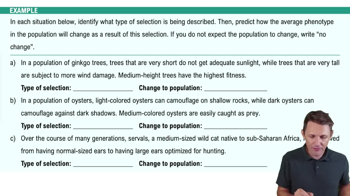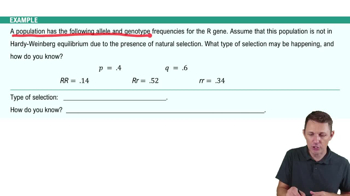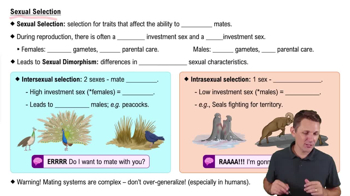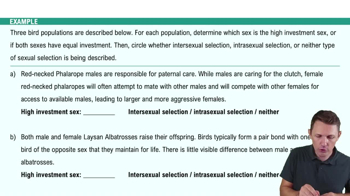Table of contents
- 1. Introduction to Biology2h 40m
- 2. Chemistry3h 40m
- 3. Water1h 26m
- 4. Biomolecules2h 23m
- 5. Cell Components2h 26m
- 6. The Membrane2h 31m
- 7. Energy and Metabolism2h 0m
- 8. Respiration2h 40m
- 9. Photosynthesis2h 49m
- 10. Cell Signaling59m
- 11. Cell Division2h 47m
- 12. Meiosis2h 0m
- 13. Mendelian Genetics4h 44m
- Introduction to Mendel's Experiments7m
- Genotype vs. Phenotype17m
- Punnett Squares13m
- Mendel's Experiments26m
- Mendel's Laws18m
- Monohybrid Crosses19m
- Test Crosses14m
- Dihybrid Crosses20m
- Punnett Square Probability26m
- Incomplete Dominance vs. Codominance20m
- Epistasis7m
- Non-Mendelian Genetics12m
- Pedigrees6m
- Autosomal Inheritance21m
- Sex-Linked Inheritance43m
- X-Inactivation9m
- 14. DNA Synthesis2h 27m
- 15. Gene Expression3h 20m
- 16. Regulation of Expression3h 31m
- Introduction to Regulation of Gene Expression13m
- Prokaryotic Gene Regulation via Operons27m
- The Lac Operon21m
- Glucose's Impact on Lac Operon25m
- The Trp Operon20m
- Review of the Lac Operon & Trp Operon11m
- Introduction to Eukaryotic Gene Regulation9m
- Eukaryotic Chromatin Modifications16m
- Eukaryotic Transcriptional Control22m
- Eukaryotic Post-Transcriptional Regulation28m
- Eukaryotic Post-Translational Regulation13m
- 17. Viruses37m
- 18. Biotechnology2h 58m
- 19. Genomics17m
- 20. Development1h 5m
- 21. Evolution3h 1m
- 22. Evolution of Populations3h 52m
- 23. Speciation1h 37m
- 24. History of Life on Earth2h 6m
- 25. Phylogeny2h 31m
- 26. Prokaryotes4h 59m
- 27. Protists1h 12m
- 28. Plants1h 22m
- 29. Fungi36m
- 30. Overview of Animals34m
- 31. Invertebrates1h 2m
- 32. Vertebrates50m
- 33. Plant Anatomy1h 3m
- 34. Vascular Plant Transport2m
- 35. Soil37m
- 36. Plant Reproduction47m
- 37. Plant Sensation and Response1h 9m
- 38. Animal Form and Function1h 19m
- 39. Digestive System10m
- 40. Circulatory System1h 57m
- 41. Immune System1h 12m
- 42. Osmoregulation and Excretion50m
- 43. Endocrine System4m
- 44. Animal Reproduction2m
- 45. Nervous System55m
- 46. Sensory Systems46m
- 47. Muscle Systems23m
- 48. Ecology3h 11m
- Introduction to Ecology20m
- Biogeography14m
- Earth's Climate Patterns50m
- Introduction to Terrestrial Biomes10m
- Terrestrial Biomes: Near Equator13m
- Terrestrial Biomes: Temperate Regions10m
- Terrestrial Biomes: Northern Regions15m
- Introduction to Aquatic Biomes27m
- Freshwater Aquatic Biomes14m
- Marine Aquatic Biomes13m
- 49. Animal Behavior28m
- 50. Population Ecology3h 41m
- Introduction to Population Ecology28m
- Population Sampling Methods23m
- Life History12m
- Population Demography17m
- Factors Limiting Population Growth14m
- Introduction to Population Growth Models22m
- Linear Population Growth6m
- Exponential Population Growth29m
- Logistic Population Growth32m
- r/K Selection10m
- The Human Population22m
- 51. Community Ecology2h 46m
- Introduction to Community Ecology2m
- Introduction to Community Interactions9m
- Community Interactions: Competition (-/-)38m
- Community Interactions: Exploitation (+/-)23m
- Community Interactions: Mutualism (+/+) & Commensalism (+/0)9m
- Community Structure35m
- Community Dynamics26m
- Geographic Impact on Communities21m
- 52. Ecosystems2h 36m
- 53. Conservation Biology24m
22. Evolution of Populations
Natural Selection
Struggling with General Biology?
Join thousands of students who trust us to help them ace their exams!Watch the first videoMultiple Choice
The graph below shows the average tail length of a population of deer mice. The first graph shows the tail length of the mice while living in a prairie ecosystem, and the second shows the tail length many generations after a group of mice moved into a forest ecosystem. Which of the following types of natural selection describes this scenario, and what conclusion could you draw from these data?

A
Stabilizing selection: shorter-tailed mice had increased fitness in the forest ecosystem.
B
Stabilizing selection: longer-tailed mice had increased fitness in the forest ecosystem.
C
Directional selection: shorter-tailed mice had increased fitness in the forest ecosystem.
D
Directional selection: longer-tailed mice had increased fitness in the forest ecosystem.
 Verified step by step guidance
Verified step by step guidance1
Examine the graphs: The first graph represents the tail length distribution of deer mice in a prairie ecosystem, showing a normal distribution centered around a specific tail length. The second graph represents the tail length distribution after many generations in a forest ecosystem, showing a shift in the distribution.
Identify the type of selection: In the prairie ecosystem, the tail length distribution is centered around a mean value. In the forest ecosystem, the distribution has shifted, indicating a change in the average tail length. This shift suggests directional selection, where one extreme of the trait is favored over others.
Determine the favored trait: The shift in the distribution towards longer tail lengths in the forest ecosystem suggests that longer-tailed mice had increased fitness in this environment. This is because the distribution has moved in the direction of longer tails.
Understand directional selection: Directional selection occurs when environmental pressures favor one extreme phenotype over others, leading to a shift in the population's trait distribution over generations. In this case, longer tails are favored in the forest ecosystem.
Draw a conclusion: Based on the shift in tail length distribution, the scenario is best described by directional selection, where longer-tailed mice had increased fitness in the forest ecosystem. This conclusion aligns with the observed data and the principles of natural selection.

 4:43m
4:43mWatch next
Master Natural Selection with a bite sized video explanation from Bruce Bryan
Start learning





